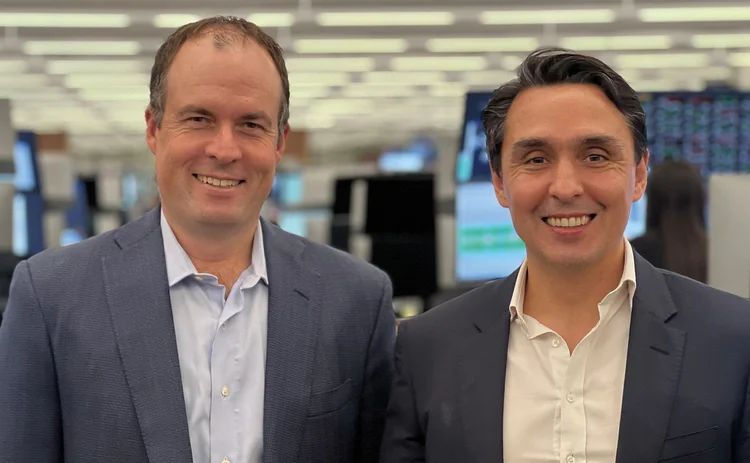
Structured products house of the year: JP Morgan
Risk Awards 2023: Tech investment propels fixed income expansion and back-to-back autocall hedges

If last year is any indication, a paradigm shift may be under way in the market for structured products. Rising rates and tumbling equity prices weighed on sales of autocallable bonds, which dominated retail channels for more than a decade, and boosted demand for a smorgasbord of other structures.
The shift played into the hands of JP Morgan, which wants to become – in the words of Ludovic Peiron, co-head of equity derivatives sales and marketing – “the wholesale Amazon of structured products”.
The bank more than doubled its US structured notes issuance in 2022, to $37 billion, with over $20 billion in sales linked to fixed income, currencies and commodities.
Popular products ranged from 40-year puttable floating rate notes to so-called Phoenix autocalls on interest rates and digital barrier notes on constant maturity swaps and crude oil.
Besides the fact we can come back with quotes in a timely fashion, we can come back with competitive prices because the stochastic adjustment fits exactly the product
Ludovic Peiron, JP Morgan
Point-to-point products with fixed expiry dates – essentially non-autocall business – accounted for 60% of activity, up from 36% in 2021. In US vanilla fixed income alone, the bank issued more than 700 deals.
Issuance at the scale and scope requires advanced systems. Since 2019, JP Morgan’s equities division has worked with the bank’s technology teams to bring automation to the forefront of the structured products business. This led to a flurry of innovations, ranging from auto-pricing tools to ‘deep hedging’ of options payouts and a new ‘back-to-back’ hedging system that automatically transfers risks associated with autocalls to hedge funds.
“Our goal has been to disrupt the market with automation,” says Peiron.
The technology allowed JP Morgan to process more than 19 million requests for quotes (RFQs) last year.
“It’s really a scale and efficiency story,” says Scott Mitchell, who co-heads equity derivatives sales and marketing with Peiron.
But that doesn’t mean a one-size-fits-all approach. The bank’s so-called omni-channel strategy supports a collection of 30 single-dealer pricing platforms, each tailored to different client segments.
The flagship structured products pricing platform for US distributors – known as SI 360 – handled over $4.5 billion trades in 2022. Clients describe the platform, which has 12,000 users across over 165 counterparties, as best-in-class. “It’s easy to use for wholesalers, and has been a great asset,” says one.
Last year, SI 360 was updated with a new machine learning tool for pricing stochastic volatility that shaved two minutes off autocall pricing, saving the bank 4,500 hours in annual computation time.

“Besides the fact we can come back with quotes in a timely fashion, we can come back with competitive prices because the stochastic adjustment fits exactly the product,” says Peiron.
Clients in Japan use a different version of the platform, called JSI, which handled around 1,000 RFQs in 2022. Meanwhile, European clients still prefer the bank’s email pricer for structured products quotes.
“The whole omni strategy is to be everywhere our clients want us to be, and face them however they want to face us,” says Mitchell.
This mentality extends to the bank’s quantitative investment strategies (QIS) business, which registered a 30% jump in notional linked to proprietary indexes in 2022. “We want to be able to have customisation at scale,” says Peiron. “If someone wants something tailor-made, we can offer that customisation. It’s the same for our QIS.”
What many retail investors wanted in 2022 were replacements for traditional 60/40 strategies, which performed particularly poorly as stocks and bonds fell in tandem. JP Morgan identified appealing alternatives in its QIS business, and quickly repackaged these institutional-focused products for a retail audience. A top-performing commodity trading adviser (CTA) strategy with a seven-year live track record was converted into a retail-friendly Ucits format for the bank’s distribution clients. Of $5 billion client balances linked to the trend-following strategy, around $1 billion was traded on the Ucits version, which went live in 2021. The index returned over 20% for the year with 10% volatility, driven largely by FX and rates.
Arnaud Jobert, co-head of global strategic indices, says repackaging the index for retail required “a fair amount of customisation” due to the the risk-monitoring requirements for Ucits and the limits on commodities.
“A lot of thought process went into turning the flagship CTA index into something we believe is very efficient as an integrated product within the Ucits fund,” he tells Risk.net.
Backup plan
While autocall activity was down in 2022, it certainly wasn’t out.
The products represented around 40% of US notes issuance in 2022, and remain an area of innovation for JP Morgan. Last year, the bank sold almost $300 million of notes linked to its MerQube Vol Advantage Indexes, which provide volatility-controlled exposure to major US indexes.
“If the equity market rallies back, would we reasonably expect autocalls to come back? History would indicate that they would, and we’ll be there to participate in that and meet demand,” says Mitchell.
“To the extent that autocalls are less in demand this year, it has really focused everyone back on product innovation as well as tech automation, which is a very good thing for the industry.”
The big innovation last year was a new approach to back-to-back risk recycling. Autocallable notes leave issuers exposed to an array of complex exotic parameters, such as volatility, correlation and dividends, which can generate heavy hedging losses in down markets. Banks typically hedge some of these risks by slicing and dicing exposures into attractive payouts for sophisticated investors. Common risk transfer trades include geometric dispersion, variance swaps and dividend swaps.
Alternatively, they can offload the full spectrum of exotic parameters associated with autocall exposure via back-to-back hedges. JP Morgan scaled up this activity with a “handful” of key clients in 2022, hedging over $500 million notional of autocall exposure in this way.
“We want to have a number of tools at our disposal to be able to hedge our inventory,” says Rui Fernandes, the bank’s global head of equities and credit structuring.
We’re a bit unique in that we have a strong retail presence in every market in the world ... We stand out as a counterparty because we’re present in every area on the issuance side
Scott Mitchell, JP Morgan
To avoid cherry-picking by hedge funds, some banks use back-to-back hedges for a slice of their autocall books. JP Morgan, in contrast, prefers to offer back-to-back hedges on a trade-by-trade basis.
In a typical example, JP Morgan receives a schedule of pre-agreed parameters from a hedge fund client on the kind of flow it is seeking exposure to – for example, US autocalls on large cap names, European index trades or Asian worst-of baskets. When the bank receives requests from distributors for products that match the desired characteristics, the hedge fund is committed to taking a portion of that volume. JP Morgan typically retains half of any single trade as skin in the game.
“We’re a bit unique in that we have a strong retail presence in every market in the world. From a hedge fund perspective, if you’re thinking about short-dated US autocalls or long-dated global index exposure, we can combine the matrix of buckets of what you want. We stand out as a counterparty because we’re present in every area on the issuance side,” says Mitchell.
The pre-trade commitment means the bank can perfectly time its back-to-back hedges with issuance, avoiding the need for any temporary hedges.
“The hedging counterparty is committed to taking a portion of that volume, otherwise you lose the efficiency of the immediate back-to-back hedge. You don’t want a situation where we need to put on our own hedges and then unwind those hedges to give them the autocall back-to-back, so it’s always a straight-through process between electronic client origination and trading, with back-to-back hedging at the same exact economic terms,” says Fernandes.
While the bank expects to do more of this, it will be limited to a small number of strategic partners.
“There is a lot of tech integration required between JP Morgan and the back-to-back partners. The client requires us to show them risk views and barrier events. We give them a lot of tools to monitor the risks of an autocall,” says Fernandes.
“We can’t give them access to our risk systems, but we can share some portfolio risk view that the back-to-back hedging counterparty gets delivered – we try to help them get better access to that.”
JP Morgan is also continuing to roll out its machine learning system for derivatives hedging to more exotics payouts. Deep hedging of Euro Stoxx 50 cliquet options – a series of short-dated resetting contracts, which are a key building block of the market for fixed index annuities – went live in 2022.
“Although it’s a relatively complex payoff, it tends to be mostly on fairly vanilla underlying indexes as opposed to single stocks of multi-index. The single index makes it slightly easier for that payoff to interact with the AI,” says Mitchell.
Next, the bank plans to begin deep hedging S&P 500 cliquets, before expanding it to other exotic exposures.
Only users who have a paid subscription or are part of a corporate subscription are able to print or copy content.
To access these options, along with all other subscription benefits, please contact info@risk.net or view our subscription options here: http://subscriptions.risk.net/subscribe
You are currently unable to print this content. Please contact info@risk.net to find out more.
You are currently unable to copy this content. Please contact info@risk.net to find out more.
Copyright Infopro Digital Limited. All rights reserved.
As outlined in our terms and conditions, https://www.infopro-digital.com/terms-and-conditions/subscriptions/ (point 2.4), printing is limited to a single copy.
If you would like to purchase additional rights please email info@risk.net
Copyright Infopro Digital Limited. All rights reserved.
You may share this content using our article tools. As outlined in our terms and conditions, https://www.infopro-digital.com/terms-and-conditions/subscriptions/ (clause 2.4), an Authorised User may only make one copy of the materials for their own personal use. You must also comply with the restrictions in clause 2.5.
If you would like to purchase additional rights please email info@risk.net
More on Awards
Market liquidity risk product of the year: Bloomberg
Bringing clarity and defensibility to liquidity risk in a fragmented fixed income market
FRTB (SA) product of the year: Bloomberg
A globally consistent and reliable regulatory standardised approach for FRTB
Best use of cloud: ActiveViam
Redefining high-performance risk analytics in the cloud
Best use of machine learning/AI: ActiveViam
Bringing machine intelligence to real-time risk analytics
Collateral management and optimisation product of the year: CloudMargin
Delivering the modern blueprint for enterprise collateral resilience
Flow market-maker of the year: Citadel Securities
Risk Awards 2026: No financing; no long-dated swaps? “No distractions,” says Esposito
Pricing and analytics: fixed income – Quantifi
Quantifi delivers high-performance, transparent and adaptable pricing and risk analytics for fixed income and credit markets
Derivatives house of the year: Citi
Risk Awards 2026: Rev up, RWAs down, as US bank gets back on track (with added XiNG and XiP)







